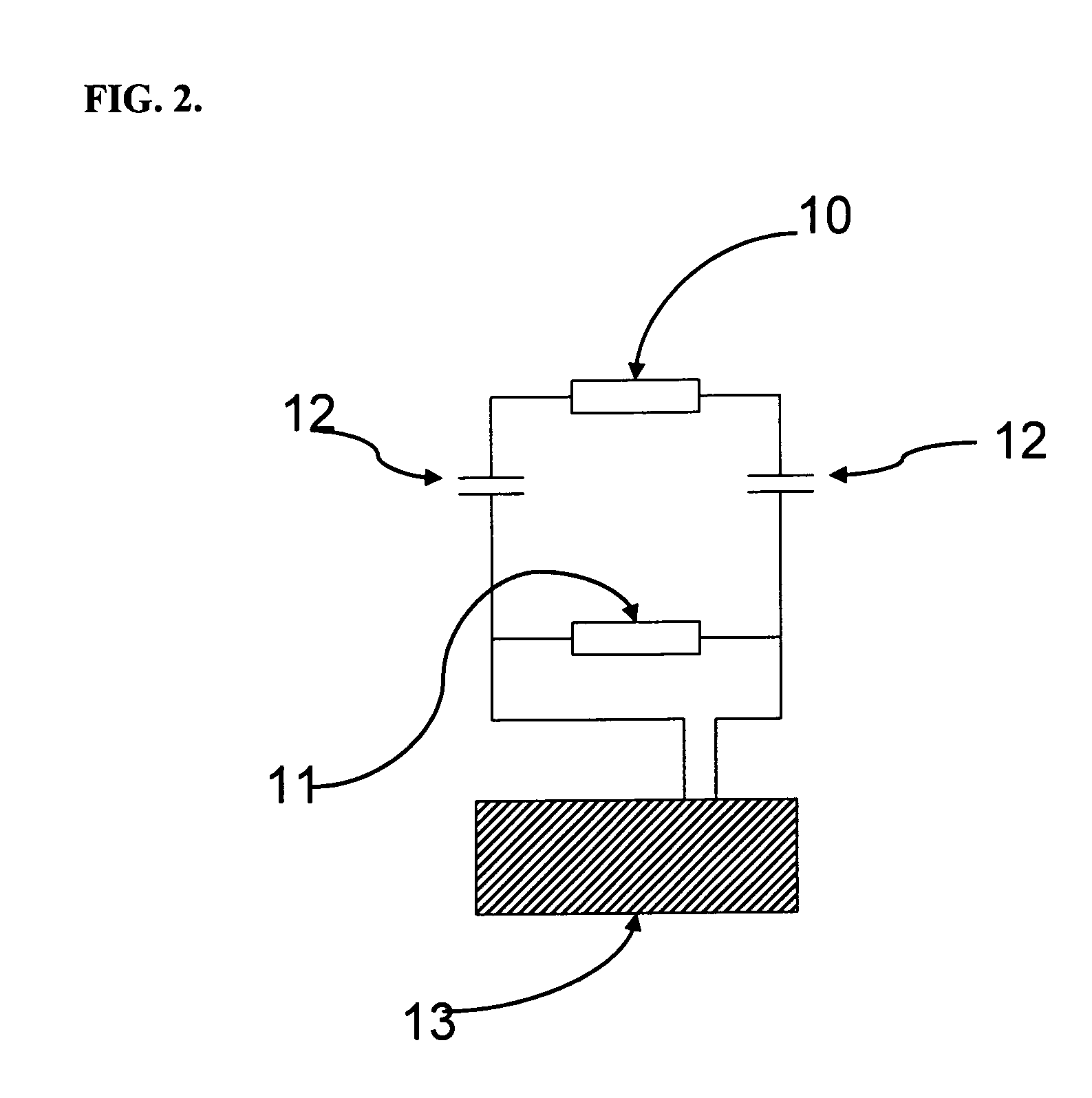Chemiresistor for use in conducting electrolyte solution
a chemiresistor and conducting electrolyte technology, applied in the field of chemical sensors, can solve the problems of not teaching the use of conducting nanoparticle based chemiresistors, desensitizing the performance of sensors, etc., and not being suitable for liquid phase detection
- Summary
- Abstract
- Description
- Claims
- Application Information
AI Technical Summary
Benefits of technology
Problems solved by technology
Method used
Image
Examples
example 1
Synthesis of DMAP-Au gold nanoparticles
[0128]Gold nanoparticles were synthesised following the Brust method (Brust, M. et al. J. Chem. Soc. Chem. Commun 1994, 801-802) and transferred to the aqueous phase following the method by Gittins (Gittins, D. I.; Caruso, F. Angew. Chemie Int. Ed. 2001, 40, 3001-3004). Briefly, a solution of HAuCl4 was added to a stirred solution of tetraoctylammonium bromide (TOAB) in toluene. Stirring was continued for 10 min and was followed by the addition of sodium borohydride which resulted in reduction of the gold. After 2 hours, the lower aqueous phase was removed and the toluene phase was subsequently washed twice with sulfuric acid, twice with sodium carbonate and twice with water. For the spontaneous and complete phase transfer of the nanoparticles from the organic to the aqueous phase, an aqueous solution of dimethylamino pyridine (DMAP) was added to the as-prepared nanoparticles. The solution containing the DMAP coated gold nanoparticles (DMAP-Au)...
example 2
Preparation of Band Microelectrodes
[0129]Glass microscope slides were cleaned and coated by vacuum evaporation with an adhesion layer of chromium, followed by a layer of gold. Standard photolithography techniques and etching techniques were used to produce a band microelectrode as shown in FIG. 1 consisting of two parallel gold electrodes that were 3 mm long, 5 microns wide and separated by a 5 micron gap between the two gold electrodes. An array of six such band microelectrodes were produced on each glass slide.
[0130]The glass slides patterned with the six gold band microelectrodes were pre-treated with a silylating agent (mercaptopropyl triethoxysilane, MPTES) prior to gold nanoparticle deposition for better adhesion of the nanoparticle to the glass and the electrode surface. Thus, the glass slides were immersed in a solution containing 2% v / v MPTES in toluene for two hours, followed by rinsing with copious amounts of toluene and drying under a gentle stream of nitrogen. The treat...
example 3
Formation of Chemiresistor Sensors Using Inkjet Printing Using a 1% w / v DMAP-Au Solution
[0131]Inkjet printing of DMAP-Au solution was carried using an Autodrop printing system (from Microdrop Technologies, Germany). The printhead used was an AD-K-501 micropipette (25 μL holding volume, 70 μm diameter nozzle). The micropipette was filled with a 1% w / v DMAP-Au aqueous solution that had been placed in a 96-well plate positioned on the printing platform. A rectangular voltage pulse was applied to dispense droplets from the micropipette nozzle with a typical droplet volume of 180 pL. The drop frequency was set at 200 Hz and the tip of the micropipette was positioned 1 mm above the substrate during the printing process. The band microelectrodes were prepared as per example 2 and were positioned on the inkjet printer platform in a suitable position.
[0132]Subsequently, 10 drops of a 1% w / v DMAP-Au aqueous solution were then inkjet-printed over each of the six band microelectrodes on the gla...
PUM
| Property | Measurement | Unit |
|---|---|---|
| distance | aaaaa | aaaaa |
| distance | aaaaa | aaaaa |
| diameter | aaaaa | aaaaa |
Abstract
Description
Claims
Application Information
 Login to View More
Login to View More - R&D
- Intellectual Property
- Life Sciences
- Materials
- Tech Scout
- Unparalleled Data Quality
- Higher Quality Content
- 60% Fewer Hallucinations
Browse by: Latest US Patents, China's latest patents, Technical Efficacy Thesaurus, Application Domain, Technology Topic, Popular Technical Reports.
© 2025 PatSnap. All rights reserved.Legal|Privacy policy|Modern Slavery Act Transparency Statement|Sitemap|About US| Contact US: help@patsnap.com



